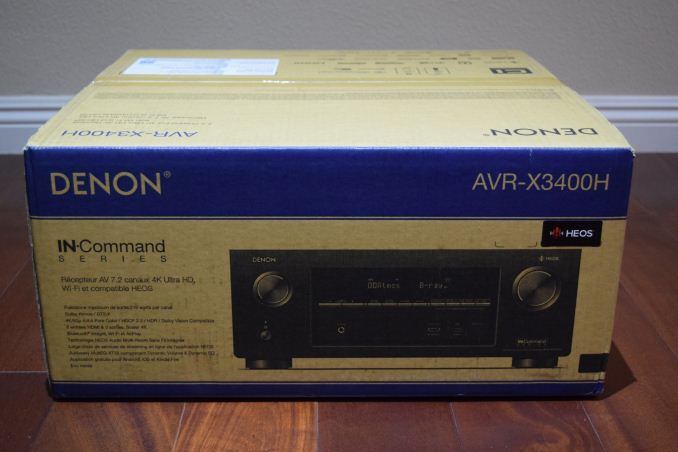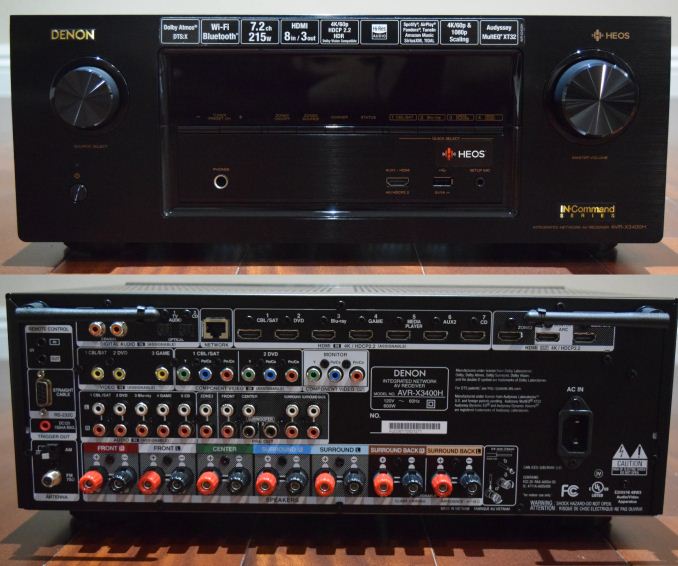A Budget Home Theater & PC Setup: 4K, HDR, UHD Blu-ray, and More
by Ganesh T S on December 26, 2017 8:30 AM ESTThe AVR: Denon X3400H
The choice of AVRs used to be a difficult one to make when support for different HD audio formats was not widespread. Now, the requirements boil down to the AVR being able to support the latest HD audio formats (Dolby Atmos and DTS-X), while matching the capabilities of the display in the chain. The additional features may help sway the purchase decision for consumers.
Budget considerations dictate the number of channels and display zones. We had to migrate from the 7.1 channel Pioneer Elite VSX-32 to a newer receiver capable of handling multiple HDMI 2.0 / HDCP 2.2 inputs with passthrough capabilities for various HDR formats. Based on my budget, I narrowed down the options to one of the models from Denon, Onkyo, Pioneer, and Yamaha. They are all in the same ball park in terms of pricing for a given feature set. We deferred to our friends at Wirecutter, who recommended the Denon AVR S730H.
I had been in touch with Denon regarding HEOS (their whole home audio solution) when the decision to go with a Denon AVR for our HTPC testing setup was taken. Upon discussing our project with them, Denon graciously agreed to sponsor the more advanced AVR X3400H for use in our testing.
The AVR X3400H targets the custom integrator channel. It has a number of additional features such as support for high end DSD audio, 4Kp60 upconversion for analog sources, multi-zone video outputs, higher power output, and support for eARC (Enhanced Audio Return Channel) to justify its higher price over the S730H. The presence of eARC makes it a bit more future-proof, as it allows for HD audio (including the new ones like Dolby Atmos and DTS-X) from the display sink to be returned to the AVR for decode and playback.
In the course of our testing, we found that the AVR received frequent firmware updates to add new features such as HLG passthrough. These point to a well-supported product. Even though the web control feature present in the previous generation Denon AVRs was missed, the Denon AVR Android app made up for it to some extent. None of the issues encountered in the course of the evaluation presented in this piece could be attributed to the Denon AVR X3400H.
If we had to give some suggestions to Denon for the improvement of the AVR X3400H, it would be to bring back the web control feature and shorten the time taken for firmware updates (though there is a facility to enable auto-updates that tries to install the new firmware when the AVR is not being used).
Speakers
Most readers upgrading their HTPC can opt to retain their existing speakers. In fact, I had the Boston Acoustics Horizon Series MCS100MDNT 5.1-channel speaker system from a 2008 purchase, along with a Jamo A306 HCS 5.1 speaker system from my 2011 home theater components upgrade. However, due to the remodel, I had to go in for in-ceiling speakers. I opted for a couple of the Polk Audio RC80i in-ceiling pairs for the rear and surround channel speakers. I bundled them along with ceiling speaker protective covers. The choice of speakers depends on the home theater size and other requirements. Currently, I am using the Jamo A306 speakers for the front, center, and subwoofer, with the Polk Audio RC80i for the other channels.












191 Comments
View All Comments
Reflex - Tuesday, January 2, 2018 - link
You are not answering my question:If I play back content that is encoded in DD5.1, 7.1 or Atmos, will your equipment do the proper object placement so that I get a sound effect in the appropriate location?
It is an important detail, if you cannot do that with the material that is available today, your solution is a solution for an audience of one. If it can do that, I am curious how it accomplishes it with what you are describing as essentially a 3.1 setup and with no Dolby or DTS license.
Bullwinkle-J-Moose - Tuesday, January 2, 2018 - link
"what you are describing as essentially a 3.1 setup and with no Dolby or DTS license."-----------------------------------------------------------------------------------------------------------------
The original reference design was 3.0
Moving the Bass speaker to a separate sub cab and calling it a 3.1 system makes zero sense
No Dolby or DTS License is correct
I do not support fake standards forged from a Real Standard
If Dolby and DTS is as good as mine, they should get a License from me
If you wish to play incompatible standards, be my guest
As I have said, I do not support Lesser Quality, incompatible or forged Standards
Dolby Vision is the same in that regard, as I or anyone else can easily create an "Open" Standard that is Visually the Equal of Dolby Vision without need for a Dolby License
Being locked into a proprietary and lesser Standard is "your" choice / not mine!
Reflex - Tuesday, January 2, 2018 - link
Then your setup is good only for you and content you produce, and for the purposes of the article and the discussion thread essentially meaningless. If you can't play back the content that is being produced accurately then it just isn't relevant to the discussion.I'm glad you enjoy your setup, I also enjoy mine.
Bullwinkle-J-Moose - Wednesday, January 3, 2018 - link
"Then your setup is good only for you and content you produce"------------------------------------------------------------------------------------
You are correct
I can produce content for anyone, and they can Lock it down with whichever proprietary standard they want for sale to people like you
My content can be encoded in the standard of the week or whatever "standard" Dolby comes out with next year
Yes, I wanted a system that can master for anyone!
and you want the finished result in a proprietary format of your choice
GOOD FOR YOU!
we are both happy with what we have!
Bullwinkle-J-Moose - Wednesday, January 3, 2018 - link
My Home Audio setups are for creating frontal 2 and 3 channel Audio ImageryI am not interested in surround but I could easily add as many surround channels as the next standard can handle
My focus is on audio production/mixing/mastering/Imaging
yet they are all I need or want for Video / Home Theater as well
All I really want is a great Audio Image in front, so I want what I have and I have what I want!
It's right for ME!
What works for you is also correct
There is no wrong standard here
You can believe in one standard, a hundred standards or none
wiyosaya - Friday, January 5, 2018 - link
I choose C: You are a troll!Aspernari - Tuesday, December 26, 2017 - link
Everything came out of your pocket, except several thousand dollars worth of stuff you recommended because you didn't have to pay for it, so it had no budgetary cost to you.Would you have really bought the $500 receiver instead of a suitable HDMI switch (if you didn't have enough HDMI ports for all your 4k sources) and using ARC or optical out from the TV with your existing receiver?
Your cost/benefit analysis is broken in this article. You keep trying to defend it, but it's not defensible.
ganeshts - Tuesday, December 26, 2017 - link
The $430 receiver was what I wanted in the build. That is what I was ready to spend my budget on.What part of the sentence 'pick and choose from the list' did you not get in the concluding section?
A HDMI switch will not do the job of the AVR.
It is not a matter of defensible or not - I have presented what worked and what didn't, even with the sponsored equipment. I have presented alternatives also. I think $349 for the AVR driving a $700 TV is a very reasonable budget - incidentally, the same amounts that I spent back in 2008 with a Toshiba Regza 46" TV and a Onkyo TX-SR606.
Aspernari - Tuesday, December 26, 2017 - link
Regarding not understanding: I understand just fine. Your choices are poorly considered and presented. I'll restate from elsewhere: You recommend readers buy $200 worth of Bluray-related hardware and deal with BSODs and/or pursue beta drivers, among other issues.Regarding the receiver: I guess you just wanted a new one, since a budget option would have been a TOSLINK cable or other solution to get audio from the TV to your existing receiver, abandoning the HDMI ports on it, and making use of an HDMI switch if you were short on HDMI ports. Total investment of about $40. Sure, you lose some of the functionality of the obsolete receiver (which you could still use fine on 1080p and lower content), but you also save $349 on sale/$430 retail/$464.40ish after tax by not buying a new receiver. Or getting someone to sponsor you.
" I have presented what worked and what didn't, even with the sponsored equipment." - You didn't present anything that I noticed that didn't work with the receiver. You state the inverse actually, "None of the issues encountered in the course of the evaluation presented in this piece could be attributed to the Denon AVR X3400H." - Which may well be true. But you also didn't evaluate the hardware you then recommend people go out and buy anyway, so the entire thing is moot. You're pushing hardware you didn't get your hands on, which just makes this all the more silly.
Imagine publishing a hardware review article, giving something a good "buy" recommendation,but never actually using the product. Oh wait - you just did that.
It's cool that you're going back and making edits based on the response here, but there's really two articles that should have written, crammed into this one:
1) A blog post about stuff you bought and the setup you made, where you can squeeze in your promotional consideration for Denon.
2) The testing you did and the issues you had navigating the current home theater market, focusing on 4k and HDR with HTPCs and high-end settop boxes.
Are you going to actually review the $1000 receiver, or is this article all that they're getting out of it?
edzieba - Tuesday, December 26, 2017 - link
"I guess you just wanted a new one, since a budget option would have been a TOSLINK cable or other solution to get audio from the TV to your existing receiver, "That's... not how things work. At all. Adding an S/PDIF cable is not going to magically allow transport of audio streams that:
a) Are too high bitrate for S/PDIF (which cannot even carry 5.1 LPCM)
b) Were developed decades after the S/PDIF standard
It's as ludicrous and nonsensical a suggestion as installing an IDE cable to allow your SATA motherboard to use m.2 PCIe NVME drives.